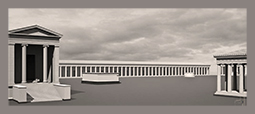 This volume is the result of a workshop held at the Department of Archaeology and Ancient History, Uppsala University, 15-16 February 2017. The theme was Urban and rural space in the Greek polis world, and the participants came from the Department of Sciences of Engineering and Architecture of the Polytechnic University of Bari, Italy, and the Uppsala Department. Three of the four articles examine civic and sacred spaces in the Dodecanese, and the fourth treats the question of how the ancient Greeks perceived and mapped space in order to orientate themselves within it.
This volume is the result of a workshop held at the Department of Archaeology and Ancient History, Uppsala University, 15-16 February 2017. The theme was Urban and rural space in the Greek polis world, and the participants came from the Department of Sciences of Engineering and Architecture of the Polytechnic University of Bari, Italy, and the Uppsala Department. Three of the four articles examine civic and sacred spaces in the Dodecanese, and the fourth treats the question of how the ancient Greeks perceived and mapped space in order to orientate themselves within it.
As the importance of the south-eastern Aegean and the coastal regions of south-western Asia Minor in the Late Classical and Hellenistic periods is becoming ever more apparent, continued research in this area allows us to gain a better understanding of these poleis and the role they played in the larger Greek world. This relatively short publication contributes to this research and also highlights the central role which highly visible sanctuaries played for travellers in unfamiliar territories.
.
Summary
.
K. Höghammar, M. Livadiotti, Introduction, pp. 5-6;
G. Rocco, Sacred architecture in Hellenistic Rhodes, pp. 7-38;
M. Livadiotti, The infrastructure of a Hellenistic town and its persistence in Imperial period: the case of Kos, pp. 39-76;
K. Höghammar, The sanctuary of the Twelve Gods in Kos and the stelai with proxeny decrees, pp. 77-100
A. Frejman, Some thoughts on ancient maps, travel, and the location of Greek rural sanctuaries, pp. 101-110.
